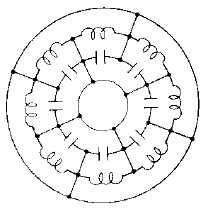2-34
Figure 2-31.—Cavities in parallel because of strapping.
Electric Field.—The electric field in the electron-resonance oscillator is a product of ac and dc
fields. The dc field extends radially from adjacent anode segments to the cathode, as shown in figure 2-
32. The ac fields, extending between adjacent segments, are shown at an instant of maximum magnitude
of one alternation of the rf oscillations occurring in the cavities.
Figure 2-32.—Probable electron paths in an electron-resonance magnetron oscillator.
The strong dc field going from anode to cathode is created by a large, negative dc voltage pulse
applied to the cathode. This strong dc field causes electrons to accelerate toward the plate after they have
been emitted from the cathode. Recall that an electron moving against an E field is accelerated by the
field and takes energy from the field. Also, an electron gives up energy to a field and slows down if it is
moving in the same direction as the field (positive to negative). Oscillations are sustained in a magnetron
because as electrons pass through the ac and dc fields, they gain energy from the dc field and give up
energy to the ac field. The electrons that give up energy to the ac field are called WORKING
ELECTRONS. However, not all of the electrons give up energy to the ac field. Some electrons take
energy from the ac field, which is an undesirable action.
In figure 2-32, consider electron Q1, which is shown entering the field around the slot entrance to
cavity A. The clockwise rotation of the electron path is caused by the interaction of the magnetic field
around the moving electron with the permanent magnetic field. The permanent magnetic field is assumed
to be going into the paper in figure 2-32 (the action of an electron moving in an H field was explained



